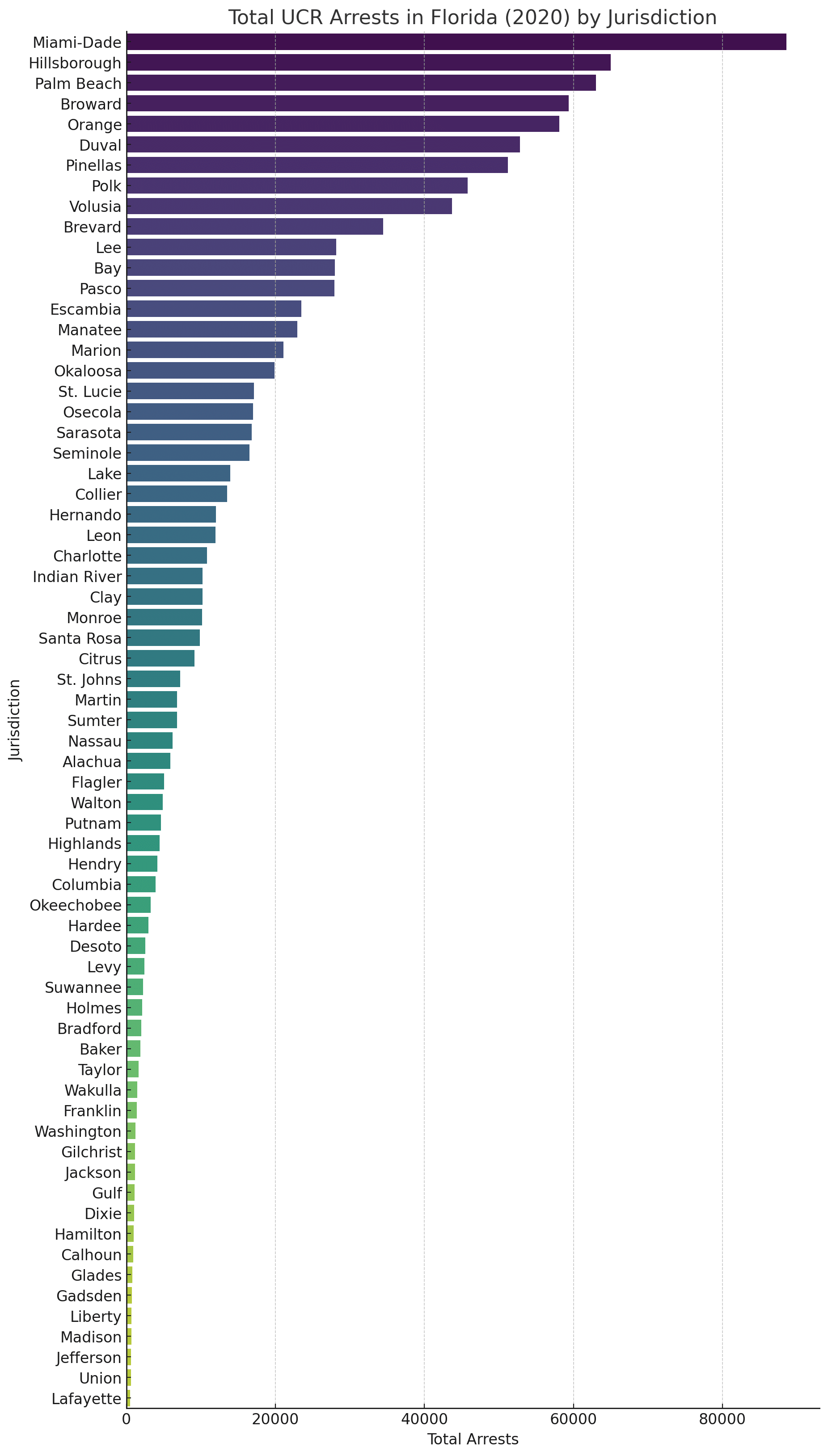According to the FDLE data report on arrest totals and index arrests by county in Florida for the year 2020. there were a total of 508,490 arrests made in Florida in 2020. This includes 476,947 adult arrests and 31,543 juvenile arrests.
The arrest rate per 100,000 population for the entire state was 2,354.5. The county with the highest total number of arrests was Miami-Dade.
Several smaller counties, such as Monroe County, had higher arrest rates per capita, with 6,513.5 arrests per 100,000. The data shows arrests for specific crimes such as murder, rape, robbery, assault, burglary, larceny, and motor vehicle theft. The file provides a breakdown of these index crimes as well as other offense categories like fraud, drug violations, DUI, and weapons violations. Overall, the data gives a comprehensive look at arrests and crime rates by county throughout Florida in 2020.
Florida experienced an increase in violent crime in 2020, but the overall crime rate has been on a downward trend. The data for 2021 shows a decrease in crime rates, but the full picture might be muddled due to changes in data collection methods and incomplete submissions from law enforcement agencies.
In an effort to better understand crime trends and patterns, it is essential to analyze and interpret data from the Uniform Crime Reporting (UCR) system. The UCR system collects data on crimes reported to law enforcement authorities across the United States, providing a valuable resource for criminologists, sociologists, legislators, city planners, the media, and other interested parties.
This article examines UCR arrest data for the state of Florida in 2020, focusing specifically on arrests broken down by jurisdiction. The data represents total arrests made by different jurisdictions, including counties and specific police departments within those counties.
In 2020, Florida experienced an increase in its reported violent crime rate of 388 per 100,000 residents, a 5% increase from 2019, according to LegalJobs. However, the overall crime rate in Florida has been on a downward trend prior to the pandemic, with an uptick in violent crime in 2020, as reported by The Marshall Project.
According to the 2021 Annual Uniform Crime Report, Florida’s total crime volume dropped 8.3% compared to 2020. The report shows that murder was down 14%, robbery was down 17.5%, and aggravated assault was down 1.6% in 2021. However, it is necessary to consider that the data collection methods have changed, and not all law enforcement agencies submitted crime statistics, which might affect the accuracy of the data, as pointed out by the Tampa Bay Times.

Upon preliminary analysis, we observe substantial variation in the number of arrests across different jurisdictions.
The numbers do not necessarily reflect the prevalence of crime in these jurisdictions. Factors such as population size, law enforcement resources, and local law enforcement policies can all significantly influence the number of arrests made in a particular jurisdiction.
what were the most common crimes in Florida in 2020
In 2020, like many states across the U.S., Florida grappled with a myriad of crimes, with property and violent crimes being the most prevalent. These crimes posed significant challenges to the safety and security of communities, prompting law enforcement agencies to deploy various strategies to combat them.
Property crimes encompass offenses such as larceny/theft, burglary, and motor vehicle theft, which constituted a significant portion of the crimes reported in Florida. Among these, larceny/theft was particularly prominent. Larceny/theft is the wrongful acquisition of another person’s property with the intent to deprive them of it permanently. The ease of committing these crimes, coupled with the potential financial gain, has made them a common occurrence not just in Florida but across the entire United States. These offenses considerably impact the community, contributing to the loss of personal property and leading to increased insurance costs.
Burglary and motor vehicle theft also form a substantial part of property crimes in Florida. Burglaries often involve breaking into a residence or business to steal valuables, while motor vehicle theft involves the unauthorized taking or attempted taking of a motor vehicle. These types of crimes can lead to significant financial loss and, in some cases, personal trauma for the victims.
In addition to property crimes, Florida saw a significant number of violent crimes in 2020, with aggravated assault being the most reported violent crime. Aggravated assault is an unlawful attack by one person upon another for the purpose of inflicting severe or aggravated bodily injury. This type of crime, often committed with a weapon, has far-reaching effects on the victims, leading to physical injury and psychological trauma.
Despite a decrease in the overall crime rate in Florida in 2020, the state saw an uptick in violent crimes, including murder. This increase in violent crime is a cause for concern and points to the need for focused strategies to curb these incidents. It is important for law enforcement, community leaders, and policymakers to understand these trends and implement effective measures to reduce both property and violent crimes, thereby ensuring the safety and well-being of all residents.
While Florida has experienced a decline in its overall crime rate, the persistent issues of property crimes and an increase in violent crimes highlight the ongoing challenges faced by the state. Efforts to address these issues require a multi-faceted approach, including community engagement, law enforcement strategies, and legislative measures aimed at crime prevention and reduction.
Insights and Future Directions
The analysis of the UCR arrest data provides valuable insights into law enforcement activity across different jurisdictions in Florida. It opens up avenues for further research into the factors contributing to the variations in arrest numbers across different jurisdictions. Additionally, this data can be further broken down by offense type and race, providing even deeper insights into arrest patterns and trends.
Understanding these trends can inform policy decisions, guide resource allocation, and shed light on the effectiveness of different crime prevention and law enforcement strategies. The arrest data only represents a portion of all criminal activity, as not all crimes are reported or result in arrests.
As we continue to explore this data in the coming months, we plan to delve deeper into the breakdown of arrests by offense type and race. This will enable us better to understand the complexities of the criminal justice system and help contribute to informed, effective policy-making in Florida.

